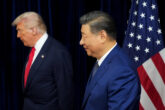April 15, 2022
Russia’s Artificial Intelligence Boom May Not Survive the War
The last year was a busy one for Russia’s military and civilian artificial intelligence efforts. Moscow poured money into research and development, and Russia’s civil society debated the country’s place in the larger AI ecosystem. But Vladimir Putin’s invasion of Ukraine in February and the resulting sanctions have brought several of those efforts to a halt—and thrown into question just how many of its AI advancements Russia will be able to salvage and continue.
Ever since Putin extolled the development of robotic combat systems in the new State Armaments Program in 2020, the Russian Ministry of Defense has been hyper-focused on AI. We have learned more about the Russian military’s focus on AI in the past year thanks to several public revelations.
The gap between Russian military aspirations for high-tech warfare of the future and the actual conduct of war today is becoming clear.
But talk of AI has been muted since the Russian invasion of Ukraine. Apart from the widespread use of UAVs for reconnaissance and target acquisition and a single display of a mine-clearing robot—all of which are remote-controlled—there is no overt evidence of Russian AI in C4ISR or decision-making among the Russian military forces, other than a single public deepfake attempt to discredit the Ukrainian government. That does not mean AI isn’t used, considering how Ukrainians are now utilizing artificial intelligence in data analysis—but there is a notable absence of larger discussion about this technology in open-source Russian media.
In January 2021, Colonel-General Vladimir Zarudnitsky, the head of the Military Academy of the Russian Armed Forces General Staff, wrote that the development and use of unmanned and autonomous military systems, the “robotization” of all spheres of armed conflict, and the development of AI for robotics will have the greatest medium-term effect on the Russian armed forces’ ability to meet their future challenges. Other MOD military experts also debated the impact of these emerging technologies on the Russian military and future balance of forces. Russia continued to upgrade and replace Soviet-made systems, part of the MOD’s drive from “digitization” (weapons with modern information technologies for C4ISR) to “intellectualization” (widespread implementation of AI capable of performing human-like creative thinking functions). These and other developments were covered in detail during Russia’s “Army-2021” conference, with AI as a key element in C4ISR at the tactical and strategic levels.
Read the full article from Defense One.
More from CNAS
-
Transatlantic Security / Technology & National Security
Look Before We Leap on Artificial IntelligenceThis article was originally published on The Dispatch. A debate about the role that artificial intelligence should and will play in society, and how it will affect humanity fo...
By Jon B. Wolfsthal
-
Technology & National Security
Caleb Withers on the Cybersecurity Frontier in the Age of AICaleb Withers, research associate at the Center for a New American Security, joins Kevin Frazier, the AI Innovation and Law Fellow at the University of Texas School of Law and...
By Caleb Withers
-
Technology & National Security
Prepared, Not ParalyzedExecutive Summary The Trump administration has embraced a pro-innovation approach to artificial intelligence (AI) policy. Its AI Action Plan, released July 2025, underscores t...
By Janet Egan, Spencer Michaels & Caleb Withers
-
Indo-Pacific Security / Technology & National Security
Sharper: Tech + ChinaRecent talks between President Donald Trump and Chinese Communist Party General Secretary Xi Jinping placed a spotlight on emerging technologies, from high-end chips to minera...
By Charles Horn & Sevi Silvia




